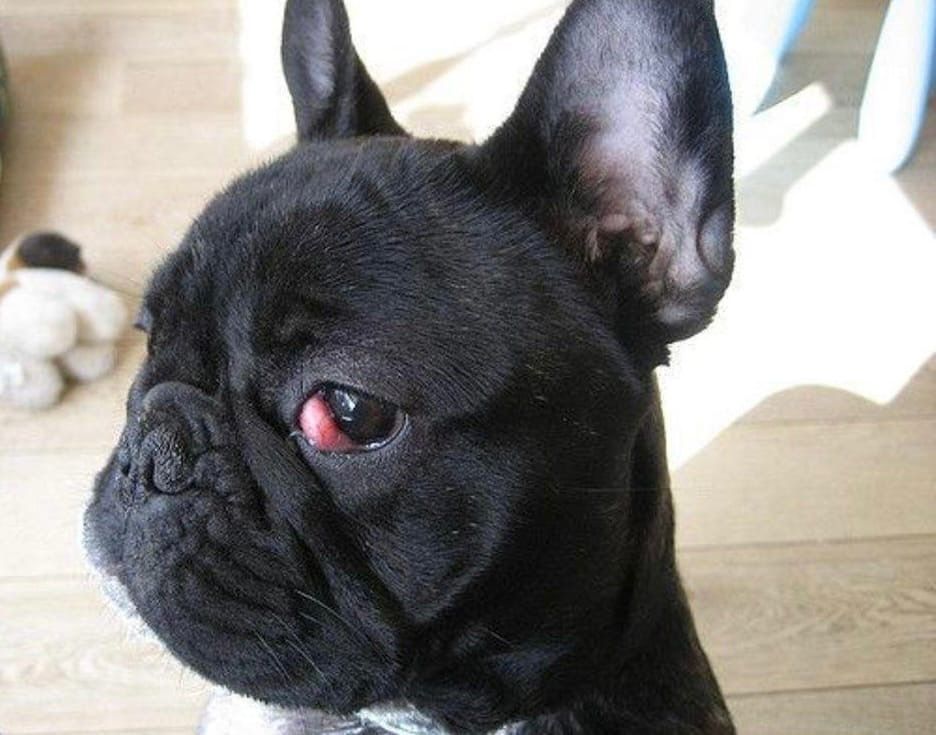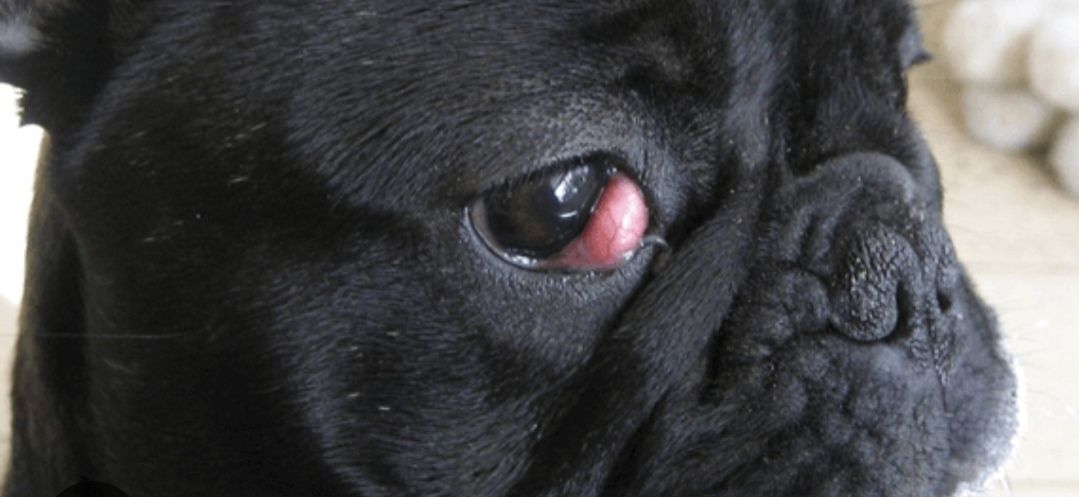French Bulldog Cherry Eye Step-by-Step Guide
1. Prepare: Gather a clean cloth and warm water.
2. Calm the Dog: Spend a few minutes petting and soothing your dog to keep them relaxed.
3. Warm Compress: Soak the cloth in warm water, wring it out, and place it gently over the dog’s closed eye for a few minutes.
4. Massage: Using gentle pressure, massage the area from the center of the closed eye towards the corner near the nose.
5. Check: Continue massaging until the third eyelid retracts.
6. Vet Follow-Up: Even if successful, visit the vet to ensure no underlying issues.
French Bulldog Cherry Eye Cause
Understanding what’s behind this eye condition is the first step towards addressing it. Let’s delve into the anatomy of your dog’s eye and the genetic factors that may contribute to cherry eye.

Understanding the Third Eyelid
Dogs have a third eyelid, known as the nictitating membrane, which houses a tear gland. This gland is responsible for a significant portion of the eye’s protective tear film. When this gland pops out of place, it becomes visible as a red or pink bulge – that’s the cherry eye. While it might not be painful, it can cause discomfort and lead to more serious issues if left untreated.
Genetics and Breed Predisposition
French Bulldogs are among the breeds that are genetically predisposed to cherry eye. This condition is most often seen in younger dogs, typically before they turn two. Although the exact cause is not always clear, it’s believed that weak connective tissue around the gland may be a contributing factor.
French Bulldog Cherry Eye Symptoms
Spotting cherry eye early on can make all the difference in managing the condition and preventing secondary problems.

Identifying the Red Bulge
The most obvious sign of cherry eye is the appearance of a red or pink bulge in the corner of your dog’s eye. It may start small and grow larger, and it’s typically more noticeable when your dog is looking up or to the side. For more information on French Bulldog health and nutrition, understanding common issues can help you keep your pet healthy.
Behavioral Changes to Watch For
Besides the visible symptoms, you might also notice your French Bulldog pawing at their eye or rubbing their face against the floor or furniture. They may blink excessively or seem to have trouble seeing. These behaviors indicate discomfort or irritation and are a clear sign that it’s time to take action.
Before rushing to the vet, there are a couple of things you can try at home to alleviate your dog’s discomfort. Let’s talk about the massage technique that might help.
French Bulldog Cherry Eye Massage
With clean hands and a gentle touch, you can attempt to massage the prolapsed gland back into place. This method isn’t always successful, but it’s worth a try, especially if you notice the cherry eye early.
Gently Massaging the Eye Using Warm Compress
Use a warm, damp cloth and gently massage the protruding gland towards the inner corner of the eye to try to reposition it back into place. The warmth can help relax the area.
You can also try using a warm tea bag compress on the eye
Gently Massaging the Eye Using Cold Compress
For some dogs, a cold compress wrapped in a smooth cloth works better than warm to reduce swelling and help reposition the gland. Go slowly and don’t force it. Hold the pressure for a few seconds and then release. Repeat several times throughout the day.
Do’s and Don’ts When Massaging Cherry Eye
Do be patient and gentle during the massage process. Don’t force the gland back into place or continue if your dog is in pain. If the gland does not reposition after several attempts, do not persist, as this could cause more harm than good.
Types of Eye Drops and Their Applications
Eye drops can be a valuable tool in managing cherry eye, especially when it comes to reducing inflammation and keeping the eye lubricated. There are various types of eye drops that may be recommended, including:
| Type of Eye Drop | Purpose | Suggested Brands |
|---|---|---|
| Lubricating/Artificial Tears | Keep the eye lubricated and moist, alleviate irritation | Genteal, Refresh Tears, Systane |
| Anti-inflammatory | Reduce swelling, help prolapsed gland retract | Maxidex, Pred-G, Vetropolycin |
| Antibiotic | Treat any infection present | Ciloxan, Polytrim, Vetropolycin (combined antibiotic/steroid) |
⚠️ Gentle Warning: Always consult with your veterinarian before using any eye drops or attempting home remedies for your dog’s cherry eye. While the above information provides general guidance, your vet’s professional advice should be followed to ensure the proper treatment and avoid any potential complications or worsening of the condition.
Application Technique for Eye Drops
Applying eye drops can be tricky, especially if your French Bulldog is wriggly. Here’s how to do it:
Ensure your hands are clean to prevent infection.
Gently restrain your dog and tilt their head back slightly.
Pull down the lower eyelid to create a ‘pocket’ for the drops.
Squeeze the prescribed number of drops into the pocket, taking care not to touch the eye with the dropper.
Release the eyelid and allow your dog to blink, spreading the medication over the eye.
Be patient and offer plenty of praise and treats during the process to create a positive association for your dog.
French Bulldog Cherry Eye Problems
Potential Complications if Left Untreated
Ignoring cherry eye can result in dry eye, also known as keratoconjunctivitis sicca, which can cause chronic discomfort and vision problems. Additionally, the exposed gland is susceptible to injury or infection, which can further complicate your dog’s condition.
Signs of Infection and Aggravation
Keep an eye out for signs of infection, such as increased redness, swelling, discharge, or a foul odor. If the eye seems more irritated after starting treatment, or if your dog’s behavior changes, such as showing signs of pain or decreased vision, these are red flags that the condition may be worsening.
French Bulldog Cherry Eye: What To Do
Assessing the Severity at Home
Examine your dog’s eye carefully. If the prolapse is small and your dog isn’t showing signs of distress, you can try the massage technique and monitor their condition closely. But, if the bulge is large, or if there’s any sign of infection or significant discomfort, it’s time to seek professional help.
When to Call the Vet
Call your vet if you notice symptoms like those described in our guide on Cherry Eye in Dogs.
The cherry eye persists after trying at-home massage.
You notice any signs of infection.
Your dog is in pain or having trouble seeing.
The eye is producing excessive discharge.
What to Expect at the Veterinarian’s Office
Your vet will perform a thorough examination of your dog’s eye. They may conduct tests to assess tear production and check for any other eye conditions. Discussing your dog’s overall health and any changes in behavior will also be part of the evaluation.
If non-surgical methods like massage and eye drops aren’t successful, surgery may be recommended to reposition the gland. This is usually an outpatient procedure, but it’s important to understand the costs involved.
French Bulldog Cherry Eye Surgery Cost
The cost of cherry eye surgery for a French Bulldog typically ranges from $300 to $1000. This cost includes pre-surgical bloodwork, anesthesia, the surgical procedure itself, and post-operative care.
The cost of cherry eye surgery can vary depending on several factors:
The severity of the prolapse.
The health of your dog and any pre-existing conditions.
The veterinary clinic’s location and the expertise of the veterinary ophthalmologist.
My Favorite Pet Insurance is Lemonade.
Because they offer the most value for money with affordable prices for the most extensive coverage.
Frequently Asked Questions (FAQ)
Can Cherry Eye Resolve on Its Own?
Unfortunately, cherry eye is unlikely to resolve on its own. While it’s not an emergency, it does require attention to prevent secondary complications. The prolapsed gland needs either to be massaged back into place or surgically repositioned to restore normal function and protect your dog’s eye health.
How Quickly Should I Act on Cherry Eye Symptoms?
You should act promptly if you notice symptoms of cherry eye. Early intervention can help manage the condition and may reduce the need for surgery. Consult with your veterinarian as soon as possible to discuss the best treatment plan for your French Bulldog.
Are Some Breeds More Prone to Cherry Eye?
Yes, certain breeds are more prone to developing cherry eye. French Bulldogs, along with other brachycephalic breeds like English Bulldogs and Boston Terriers, have a higher incidence of cherry eye. This is likely due to their facial structure and genetic factors.
Is Cherry Eye Different from Pink Eye?
Yes, cherry eye and pink eye (conjunctivitis) are different conditions. Cherry eye refers to the prolapse of the third eyelid’s gland, while pink eye is an inflammation or infection of the outer membrane of the eyeball and the inner eyelid. They require different treatments, so it’s important to get an accurate diagnosis from your vet.
What Are the Long-term Effects of Cherry Eye Surgery?
Most dogs recover well from cherry eye surgery with no long-term effects. However, as with any surgical procedure, there are risks of complications, such as infection or recurrence of the prolapse. Your vet will provide post-operative care instructions to help minimize these risks.




